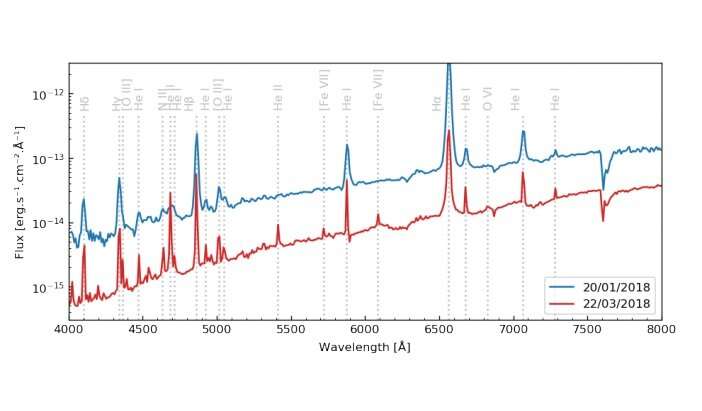October 8, 2020 report
First symbiotic star detected by Gaia satellite

An international team of astronomers reports that the transient Gaia18aen discovered by ESA's Gaia spacecraft turns out to be a symbiotic star. This makes it the first symbiotic star identified by this astrometric satellite. The finding is detailed in a paper published September 30 on arXiv.org.
Astronomers assume that symbiotic stars, which are among the widest interacting binaries, showcase dramatic, episodic changes in the spectra of their light because one of the pair is a very hot, small star, while the other is a cool giant. In general, such systems are essential for researchers studying aspects of stellar evolution.
WRAY 15-136, also known as AT 2018id, was detected and classified as an emission line star in 1966. In January 2018, Gaia spotted an outburst of this star and the transient event received designation Gaia18aen. Observations show that the star started to increase its brightness at the turn of November and December 2017 and it continued to brighten in the following weeks. One study suggested that it is a nova, based on the spectrum obtained by ESO's Very Large Telescope (VLT) in Chile.
Now, follow-up observations of Gaia18aen performed by a group of astronomers led by Jaroslav Merc of Charles University in Prague, Czech Republic, indicate that the object is a symbiotic star. For their study, the scientists used the Liverpool Telescope at La Palma, Spain and VLT. The research was complemented by photometric data from LCO 0.4-m, PROMPT 0.6-m, Terskol 0.6-m, and PIRATE robotic telescope.
"In this work, we have analyzed the photometric and spectroscopic observations of Gaia18aen, transient detected by the Gaia satellite at the beginning of the year 2018," Merc's team wrote in the paper.
The study found that Gaia18aen is a non-dusty S-type symbiotic star, about 19,500 light years away, consisting of a hot white dwarf and an M giant around 230 times larger than our sun. The giant star has a slightly super-solar metallicity and an effective temperature of about 3,500 K. Its luminosity, at a level of some 7,400 solar luminosities, makes it one of the brightest symbiotic giants. The orbital period of the system was measured to be approximately 487 days.
As noted in the paper Gaia18aen experienced an outburst of about 3.3 mag in January 2018, which was followed by re-brightenings 100, 240, and 350 days after the event. The first phase of the main outburst had a relatively high luminosity, at a level of some 27,000 solar luminosities. The main outburst was accompanied by the increase of luminosity of the white dwarf and the decrease of its temperature, as well as by the changes in emission spectral lines, which is typical for classical symbiotic stars.
The astronomers added that the light curves of Gaia18aen showcase scatter, which might be caused by stellar pulsations of the giant star with a period between 50 and 200 days. This is typical for cool components in S-type symbiotic systems.
More information: Merc et al., Gaia18aen: First symbiotic star discovered by Gaia. arXiv:2009.14709 [astro-ph.SR] arxiv.org/abs/2009.14709
© 2020 Science X Network




















